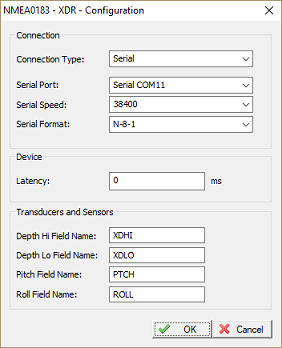My dual frequency echo sounder only supports the NMEA0183 output format. How does Hydromagic know which depth is high and which is low frequency?
All depth sentences defined in the NMEA0183 protocol specification are designed for single frequency use. At the moment of writing there are no NMEA0183 sentences which can be used to support dual frequency depth data.
Some echo sounder manufacturers have found a way around this by using the "XDR" sentence in the NMEA0183 protocol. This is a data sentence which can be used to transfer sensor data from a device to a computer.
For dual frequency echo sounders, the fields "XDLO" and "XDHI" are used (which means transducer low and transducer high).
$SDXDR,D,2.85,M,XDHI,D,2.92,M,XDLO,C,23.16,C,WTHI*77 $SDXDR,D,2.83,M,XDHI,D,2.92,M,XDLO,C,23.16,C,WTHI*71Example NMEA0183 XDR data sentences
When your echo sounder does not output this XDR sentence, you can only read the high frequency depth data from the device.
To decode dual frequency data from an echo sounder which uses XDR sentences, you can use the "XDR" plugin which is shipped with the Hydromagic installer software.
For more information on how to load, configure and troubleshoot this plugin, please refer to the "Handling NMEA0183 XDR Sentences" page in the "Articles and Howto's" section on our website.

The Hydromagic XDR plugin can be loaded to decode
dual frequency depth data via NMEA0183.
